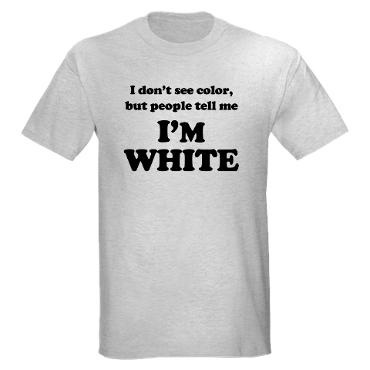Jim Crow Museum
1010 Campus Drive
Big Rapids, MI 49307
[email protected]
(231) 591-5873
Interesting website you have. My approach is different, I don't see skin color.
--Haworth Stevens- Los Angeles, California
Yes, you do.

You see skin color, I see skin color; we all see skin color. Saying "I don't see skin color or race" is naive, even when it well-intentioned. When we meet others we notice their physical characteristics-skin color, height, body shape, hair, and so forth. There is nothing wrong with being different and there is nothing inherently wrong with noticing differences. So, when I say we see skin color, I first mean that we literally see and mentally register our perception of someone's skin color.
One problem is that for many of us, we don't simply notice a person's skin color-and presumed racial membership-but we make certain assumptions about the individual based on our understanding of people with similar skin color. If his skin is dark enough to fit the category that we associate with being an African American, then we may make assumptions about his athleticism. Maybe it is this frequent link between noticing skin color and evoking racial beliefs that makes us want to say, "I don't see skin color," even when it is obvious that we do.
When someone says to me, "I don't see skin color" or "I am"colorblind," I think they are trying to say, "I am not racially prejudiced" or "I try to avoid holding and acting on racial prejudices." I wish they would say one of these sentences instead of the "I don't see" line. Race matters. We can argue about whether it matters too much or too little, or whether it should matter at all, but there is no argument that it matters. To say that you don't see race is to say that you do not see an important part of someone's identity. That is insulting, even when it is unintentional.
Being a racial minority makes one more cognizant of racial dynamics, in part, because these minorities think about race relations more often-especially the impact of having dark skin in a society where the dominant group has lighter skin. A major privilege of being in the dominant group is that you are free to not think about race, race relations, and racism as often. Maura Cullen, in her book 35 Dumb Things Well-Intended People Say, said,
"This is a terribly naive remark to make because of course we see color. Usually we do not even make such a statement UNTIL we see color. When white people say this to people of color, you can be fairly certain that it will not be received favorably. From the perspective of the person of color, white people are attempting to eliminate race from the conversation. This renders the person of color invisible and dismisses their life experience, which results in mistrust. To deny obvious racial differences is a poignant example of how people from advantaged groups, in this instance white people, have the privilege of choosing when, and if, they want to deal with race."
I would add that it also dismisses a part of the life experiences of white people.
The Jim Crow Museum exists to help us teach and learn about race, race relations, and racism. The Museum uses objects of intolerance to teach tolerance and promote social justice. For many years I thought this meant helping to move the United States toward being a society where race no longer mattered. I now believe that the effort should be to help move the society to a place where people are not punished for being racially different, a place where differences, including cultural differences, are celebrated.
Dr. David Pilgrim
Curator / Jim Crow Museum
2013